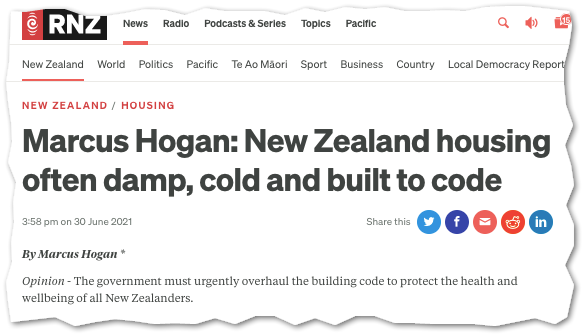In this high-profile recent opinion piece, Marcus Hogan (professional practice director at Te Kāhui Whaihanga New Zealand Institute of Architects), points out that even new homes built to meet the Building Code in New Zealand are not good enough.

He writes, “The government knew, more than 80 years ago, that there was mould in the ceilings and walls of over 50 percent of newly built homes.” I was aware that BRANZ keeps finding 40-50% of all New Zealand homes have mould; with a number that big, then necessarily some of those damp, mouldy homes are newly built. But I wasn’t aware that the government knew of the extent of the issue so long ago.
In any case, it is great to see NZIA not just supporting the new energy efficiency proposal by MBIE but going beyond it. The design approach Marcus calls for is similar to Passive House:
- require the use of a performance-based metric like kWh/m2 to measure a building’s quality
- consider thermal modelling
- eliminate thermal bridges
- air tightness
- ventilation
- increased observation of construction work and
- onsite testing.
The Building Code is the worst house you are legally allowed to build. New Zealand has a near-total short-sighted focus ofn the cost of a building on the day the keys are handed over. That fails to account for operational costs, maintenance costs and the social and financial cost of homes that make people sick. Given the ingrained cultural issues, I see no option but to improve the Building Code so as to require that all homes are warm and healthy.
As Marcus’ piece points out, there are a collection of items that need to be addressed. For Sustainable Engineering, it all starts with thermal modelling. Homeowners and designers need to know how a building will perform before it is built. Anything less is a lottery.